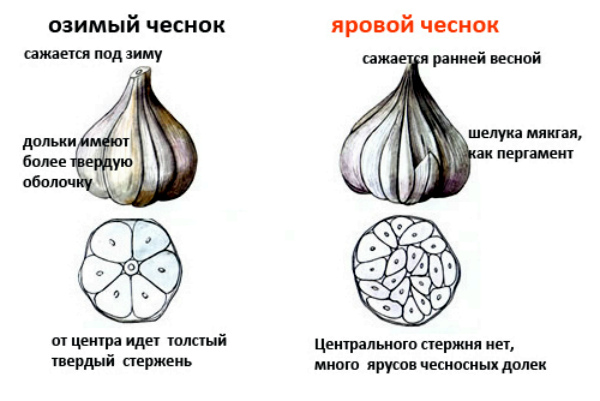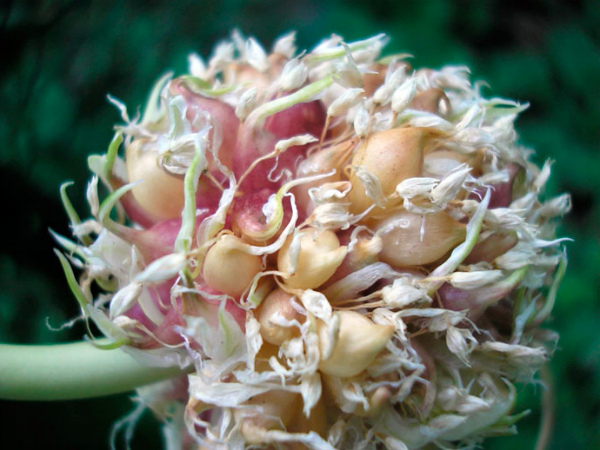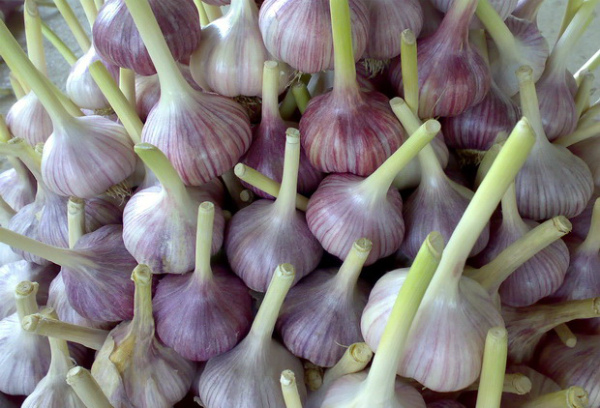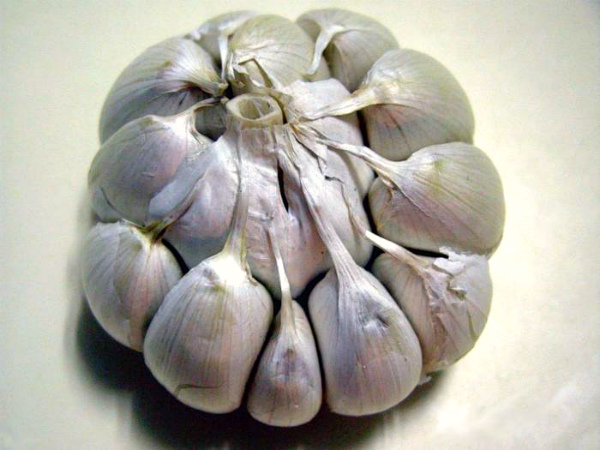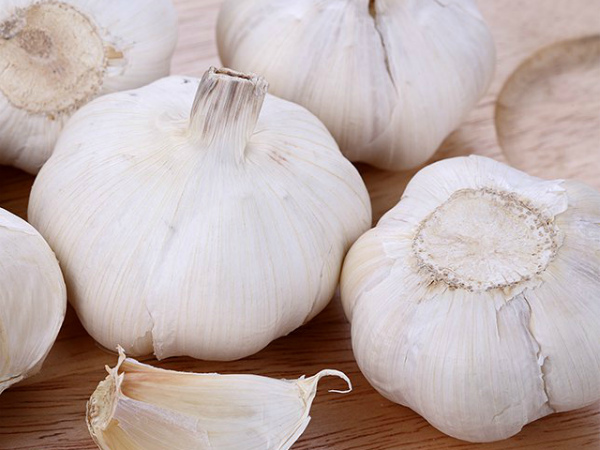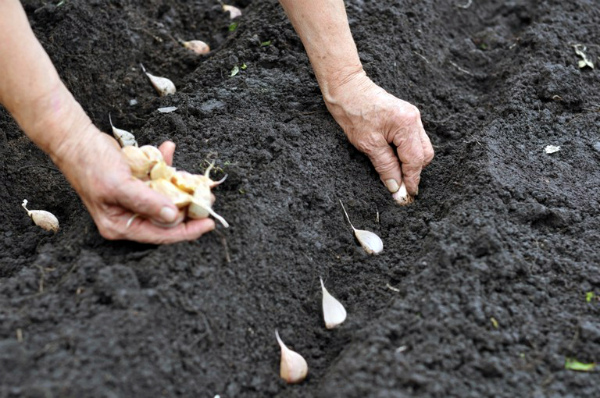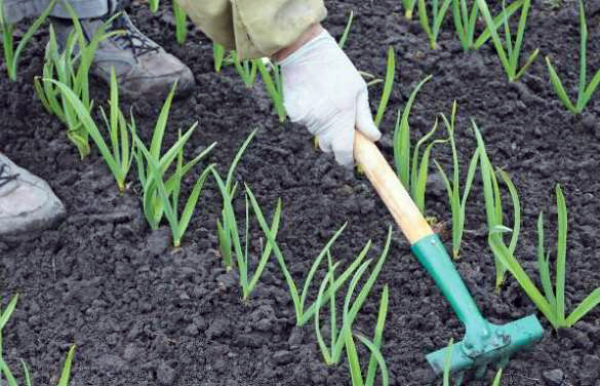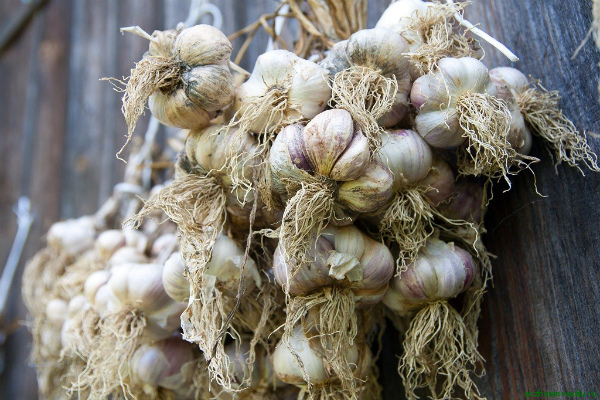Garlic Growing Guide
Content
About garlic
Garlic is a perennial herb from the genus onion, amaryllidaceae family. Active growth is noted both in the underground part, where the bulb with cloves develops, and in the aboveground, where the stem, leaves, and also air bulbs are located.
According to the growth time and the method of cultivation, this crop is divided into two groups: spring and winter. Spring garlic is planted in spring, in mid-April, at the latest in early May. Winter crops, on the contrary, are planted in the fall: from late August to early October, so that it hibernates in the garden bed.
The biology of the species also differs: the winter one produces an arrow with a bulb, which can be used for reproduction, while the spring does not have such an arrow.
In spring garlic, the bulb contains up to 30 cloves, which are arranged in a spiral from the smallest central ones to the larger ones along the outer axis. Moreover, this species shows the best keeping quality, it can be stored for up to one and a half years, while the winter one cannot show such good results.
Varieties
The choice of a variety depends a lot on the climate in your area, the type of soil and the size of the site. For rainy areas with high humidity, you should choose hybrid varieties that have much higher immunity to disease. Listed below are the varieties that, in all or almost all of the parameters, would have been approved by Mr. Likhatsky.
Winter varieties of garlic that are good to grow at home:
- Gribovsky Jubilee is a medium late variety, the bulb of which contains about 11 cloves. The pulp is elastic, the taste is very spicy.
- Komsomolets is a mid-season variety with a large, round, slightly flattened bulb. Gives about 11 sharp-tasting cloves.
- Gribovsky 60 is one of the fastest growing during the growing season. It is distinguished not only by a pungent taste, but also by increased resistance to weather conditions and diseases.
- Lyubasha - differs in unpretentiousness to the type of soil. With abundant watering, the bulb of this variety grows large (up to 120 g in weight). There are only 7 teeth, but they are large, sharp in taste.
- Polessky - great for eating the aboveground part. Green garlic produces leaves up to 50-60 cm long with a medium waxy bloom. Its bulb is dense, large, consists of 7 cloves.
- Herman - differs in mid-maturity and medium formation of a wax bloom on the leaves. Just like Polessky, this green garlic produces leaves up to 60 cm. The bulb is slightly elongated, weighs up to 54 g, contains 7-8 cloves with a very pungent taste.
- Skif is a mid-season variety with a lilac husk, a small bulb, dense and sharp pulp. Resists bacteriosis and white rot well.
- Gradekovsky is an early ripening variety that ripens in 86 days. However, it bears fruit in small bulbs.
- Bashkir 85 is another early ripening variety that reaches its peak growing season in 90 days. The bulb contains 5-6 cloves with dense, sharp pulp. Differs in high immunity from bacterial rot, onion flour, peronosporosis.
Spring varieties also shine in a variety of sizes, weights and resistance to harmful microorganisms:
- Degtyarsky - has a mid-season bulb, moderately pungent taste. Forms up to 18 teeth.
- Kledor is an interesting red variety. His husk is pink, the bulb contains up to 20 large cloves. Mid-season variety, practically not susceptible to fungal microflora.
- Flavor is a hybrid variety with extremely high immunity to diseases caused by fungi. Medium bulbs, up to 80 g.
- Messidor is a mid-season variety with large bulbs.
Sowing technology
Growing garlic is impossible without proper planting. It does not matter whether it is a spring or winter species - the sowing technology must be carried out correctly, without deviations.
Garlic loves coolness, which means it is important to plant it at the right time in order to stimulate the development of the root system and get a healthy plant in your garden.
When to plant
Spring garlic is planted in April, when the snow has already melted and the ground has warmed up to +7 ° C. At the same time, early watering is practically not needed for such varieties, there is enough natural moisture from melting snow.
Winter varieties are planted in early autumn. Depending on the cultivar, soil type and weather conditions, planting dates vary between 20 August and 10 October. It should be understood that planting too early will lead to the plant growing too much, which means that it will winter worse. But planting too late will harm him - due to an insufficiently developed root system, the culture will grow more slowly in the spring.
Soil and seed preparation
At home, it is quite easy to prepare the soil for growing garlic. He loves loamy soil, always with low acidity, moderately moist. Compliance with crop rotation is mandatory, as well as control over predecessor species. Garlic grows best after annual early and mid-season crops: peppers, eggplant, pumpkins, cucumbers. These plants are good at saturating the soil with nitrogen, which helps garlic to grow. It gives a poor harvest when grown after potatoes, radishes, turnips, carrots, which actively deplete the soil.
It is better to start soil preparation one and a half months before planting (for winter varieties), or from autumn (for spring varieties). In 1 sq. m of soil, you need to add 1 bucket of compost or humus, 1 glass of dolomite flour (if the soil is acidic), 10-15 g of superphosphate, 1 tbsp. spoon of nitrophoska. Fertilizers should be thoroughly mixed with the soil, up to 20 cm deep. After that, it is advisable to water the area with a solution of copper sulfate and cover with a film.
Since the reproduction of garlic occurs in cloves, it is necessary to select and prepare them correctly. Likhatsky notes that the biology of different varieties is suitable for different regions, so try to choose teeth that are taken from plants grown in your area. It is also important that they belong to the same variety, in order to navigate the timing of ripening. Select the largest teeth that do not have wormholes, rot, or bumps. Be sure to disinfect them to avoid accidental infection with the fungus. At home, this can be done with a pink solution of potassium permanganate, a solution of copper sulfate or ash liquor.
Landing
The answer to the question "how to grow garlic" is quite simple - do it yourself in the beds. There are several planting methods that are suitable for spring and winter garlic.
Make grooves in which the cloves will be laid, so that there is 20-25 cm of free space between them (sprinkle these areas with ash as a prophylaxis against insects). The depth of the furrow should be 16-17 cm for winter varieties and 10-12 for spring varieties.A small layer of river sand can be poured at the bottom of the furrow, which will help to avoid root rot.
Moisten the soil shortly before planting, place the teeth in the furrows at intervals of 10 cm with the sharp end up. Carefully cover the furrows with soil and sprinkle with water or yeast solution.
Another planting method is suitable for small areas. One layer of garlic cloves is placed in the furrow, covered with earth, and then the second tier of cloves is planted. After this, the garden must be mulched.
Also, garlic can be sown in a "lazy" way, simply by scattering the cloves over the garden bed, then sprinkling with earth and mulching.
Early Planting Garlic Video
These unusual planting tips will definitely come in handy if you are growing garlic in the Northwest region.
Care
Growing garlic requires minimal maintenance of the crops. It is not necessary to feed this crop during growth, except that one or two times a season you can use a liquid organic fertilizer, for example, an ash or yeast solution.
It is important to remove weeds and gently loosen the soil so that the plant gets enough nutrients, air and moisture.
You should be careful with watering - green garlic rots with an excess of moisture.
Otherwise, garlic needs warmth, a lot of light and the absence of gluttonous insects that spoil the roots and the bulb itself.
Pest and disease control
Likhatsky notes that during the growing season, viral and fungal diseases are most dangerous for garlic. Among them stand out:
- Fusarium (bottom rot), which leads to yellowing of the leaves and the rapid death of the root system, as well as rot of the bulb.
- Bacterial rot, which is manifested by brown ulcers on the bulb, the formation of rot.
- Downy mildew, due to which the leaves of garlic become covered with a gray bloom, and the vegetation slows down or, in critical cases, stops, leading to the death of the plant.
- White rot of garlic, which is manifested by yellowing and dropping of leaves, the formation of mold on the roots and bulb.
- Black mold, covering the leaves of the plant with yellow spots, followed by the formation of black mold.
As with any fungal diseases, it is better to carry out preventive spraying of beds with fungicides, for example, Topsin-M, Fitosporin. You can use an infusion of ash and nettle.
Insects do not lag behind due to malice, among which onion flies, onion hoverflies, thrips, a hidden proboscis, moths, nematodes, and ticks are seen. To protect against them, both insecticidal preparations and other crops are used. For example, nematodes do not like calendula and chicory. You can also use a variety of natural substances. A mixture of 100 g of ash, 1 tbsp. Will help from an onion fly. a spoonful of tobacco ash, 1 teaspoon of ground pepper - this powder is sprinkled on the ground in the beds with garlic.
Cleaning and storage
Harvesting garlic is best done in cloudy weather, when there is no rain or sun. It is advisable to set aside for this early morning or late evening so that the bulbs do not get burned by the sun's rays.
Spring garlic is harvested from mid-August to late September, depending on the growing season of each variety, and winter garlic is harvested in mid-July. Use flat-toothed forks to pry on the bulbs, being careful not to damage them, remove them from the ground and leave them to breathe for a few minutes. After that, clean the bulbs from the soil, being careful not to break off the roots, and fold them under the canopy.
This kind of drying should last 7-10 days, so that the vegetative processes can be safely completed. After that, you can cut the roots up to 2 cm, and the stems up to 5 cm and start preparing for further storage.
There are many ways to keep garlic intact with all its nutrients. For example, braid or tie into bouquets and then hang in a cool, dry place.Or cut into plates, dry in the oven and grind into powder. For lovers of fresh garlic at any time of the year, the method with cutting the cloves into cubes and subsequent freezing in the refrigerator is suitable. You can also store the peeled cloves in sunflower oil.
The most important rule when storing garlic is to ensure that the air temperature does not rise above +5 ° C. In a warm environment, garlic quickly loses its shape, becomes shriveled, withered, moldy and rotted.
Video "Secrets of a Great Garlic Harvest"
To get a good harvest on your site, you need to know some of the features of growing garlic. This video tells about them.

